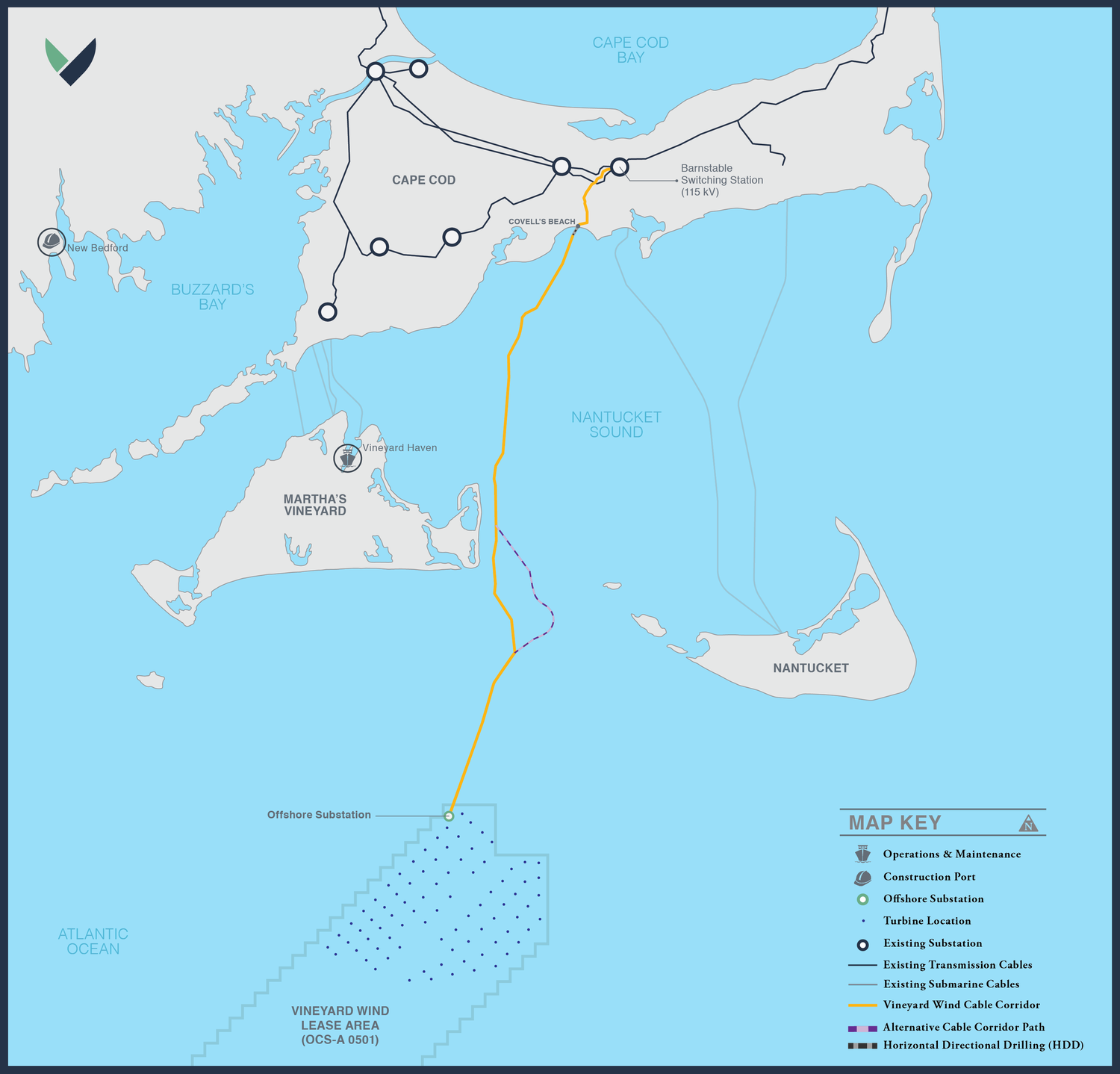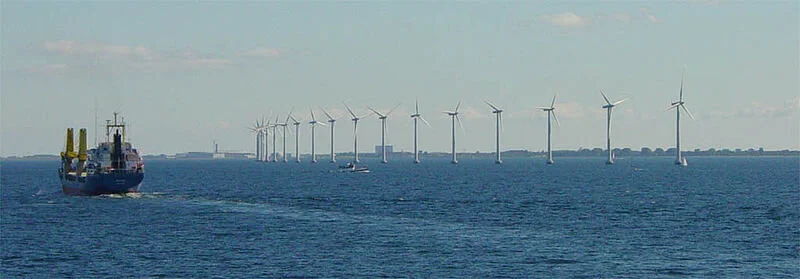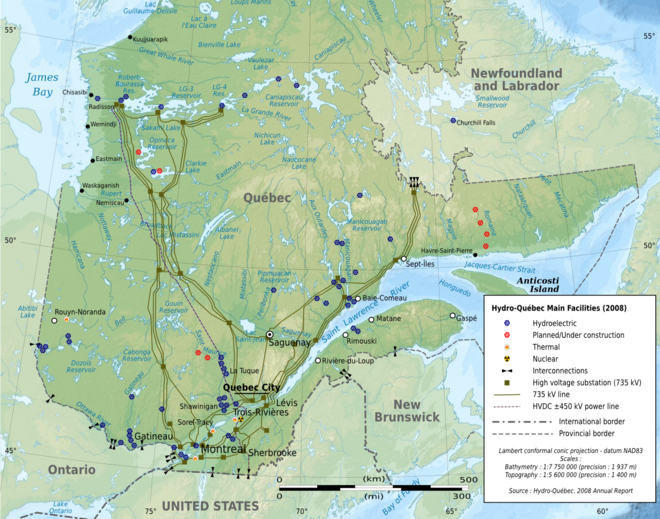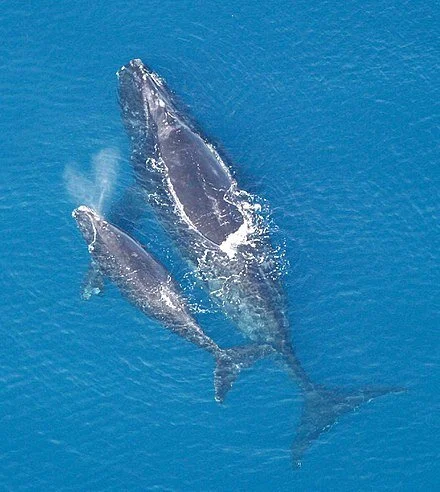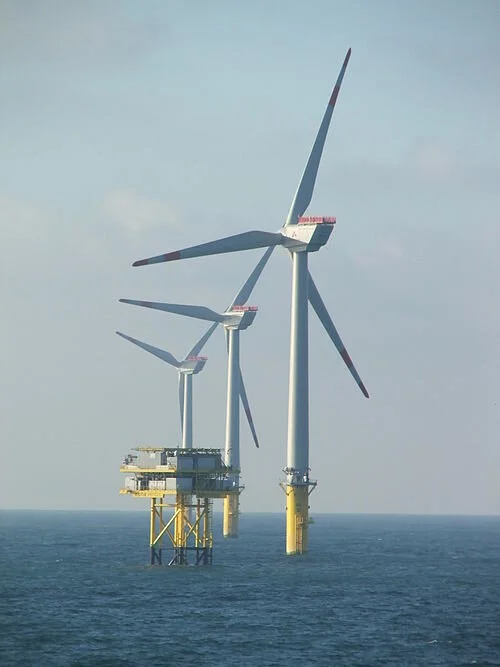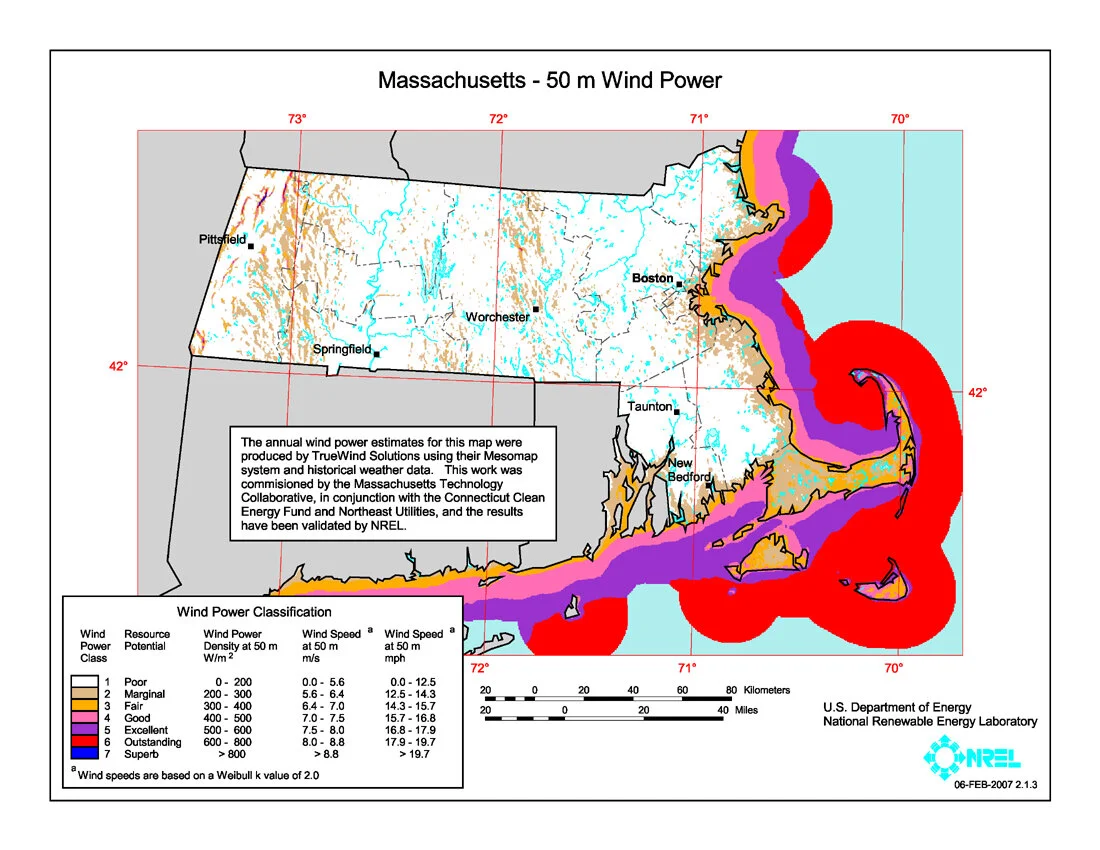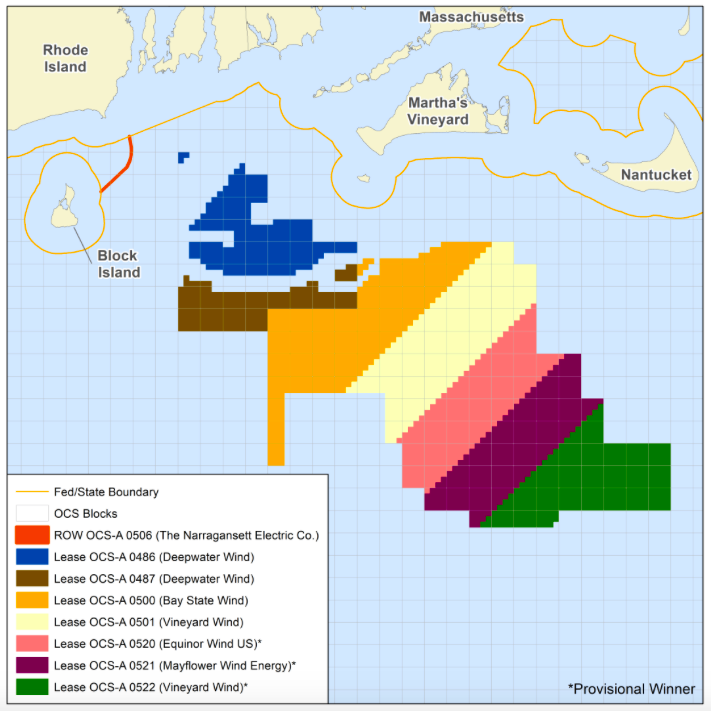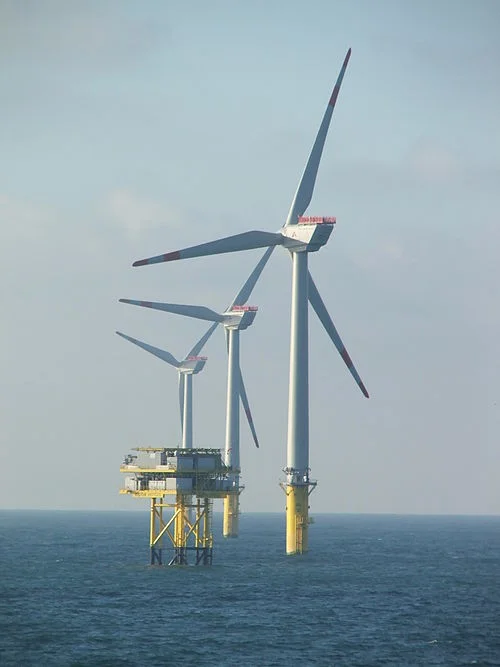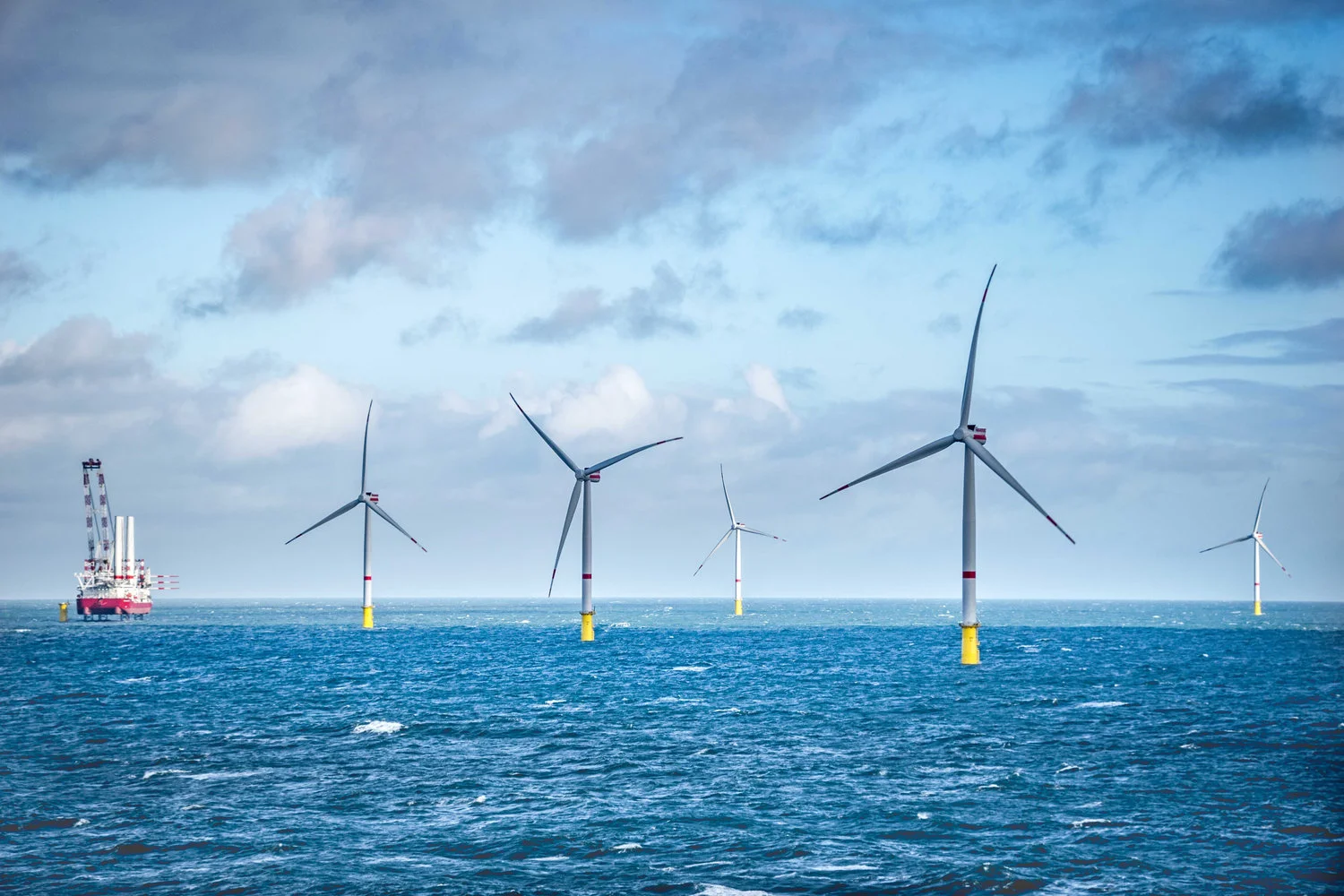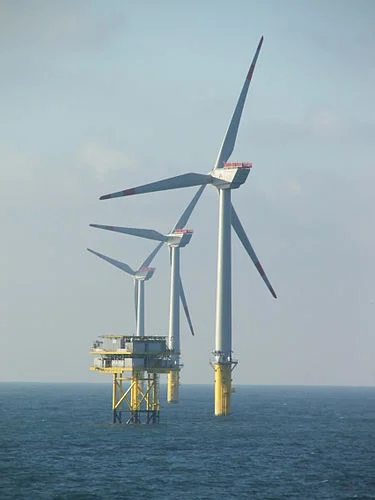Mary Lhowe: The ‘lunchbox’ from offshore wind turbines
Text from ecoRI News article by Mary Lhowe
“Opponents of offshore wind offer different reasons for their position: fear of impacts on the marine ecology; fear of loss of income for fishers; fear of loss of tourism dollars and private property values due to the sight of the turbines on the horizon.
“The cloudy threat of wind projects off the New England coast comes with a golden — not silver — lining. That gold would arrive in the form of millions of dollars contractually promised to communities by developers in the form of mitigations, sometimes through a mechanism called host community or good neighbor agreements.
Even the towns and historic property owners who dread wind farms but yearn for funds to do worthy projects could be excused for reacting to mitigation deals in similar fashion to the character Gaz in the movie The Full Monty. Watching men audition for a new amateur dance troupe, Gaz observes the impressive talents of one particular auditioner, and mutters, “Gentlemen, the lunchbox has landed.”
To read the whole article, please hit this link.
Closing on final approval of Vineyard Wind 1
From The New England Council (newenglandcouncil.com)
“Avangrid recently received the Final Environmental Impact Statement (FEIS) for Vineyard Wind 1 from the U.S. Bureau of Ocean Energy Management (BOEM), the last step before a Record of Decision (ROD) that would jumpstart approval for the project to begin construction.
“A joint venture between Avangrid Renewables and Copenhagen Infrastructure Partners (CIP), Vineyard Wind seeks to establish a massive offshore wind farm about 15 miles off the coast of Martha’s Vineyard.“Dennis V. Arriola, CEO of Avangrid, commented, “We are one step closer toward realizing this historic clean energy project and delivering cost-effective clean energy, thousands of jobs and more than a billion dollars in economic benefits to Massachusetts.” The project would generate electricity to power over 400,000 residences and businesses in Massachusetts, while also reducing electricity rates, carbon emissions, and creating new job opportunities.
“The New England Council looks forward to the progress Avangrid makes in developing this project for the region. Read more from the Hartford Business Journal and Avangrid’s press release.’’
Good news for GE and New England
Adapted from Robert Whitcomb’s “Digital Diary,’’ in GoLocal24.com
Here’s another example of how offshore wind power can be an economic boon for New England:
Vineyard Wind LLC has picked Boston-based General Electric to provide the turbines for its project south of Martha’s Vineyard – in what will be the first large-scale offshore wind farm in the United States. European nations are far ahead of us!
The wind-farm developer, a joint venture owned by Avangrid and Copenhagen Infrastructure Partners, had originally planned to put up turbines made by the Danish-Japanese venture MHI Vestas (soon to be entirely Danish).
But permitting delays led Vineyard Wind to change the wind farm’s layout and equipment. So there will be 62 GE turbines instead of the 84 planned with MHI Vestas. But those General Electric turbines are the world’s most powerful. It’s nice to think that a Massachusetts company will provide this gear for this massive New England project.
And the news may suggest a brighter future for GE, which has faced hard times the past few years.
Hint this link for more information.
Greentown and Vineyard Wind partner for offshore-windpower innovation
From The New England Council (newenglandcouncil.com):
“Greentown Labs has partnered with Vineyard Wind to develop an accelerator program for offshore wind innovation.
“Based in Somerville, Mass., Greentown Labs is a clean-tech incubator, and oversaw its first clean-energy program launch in 2015. Through this partnership, Greentown will support startups working to develop offshore wind and marine-mammal technology. An oft-overlooked facet of offshore wind, marine data-monitoring technology—which provides important information on environmental conditions necessary for offshore wind projects—is integrated into the partnership. The partnership will also provide ‘resources, training, and expert mentorship’ to startups. Greentown’s previous launch programs focused on areas such as solar, hydrogen and digital energy.
“‘We’re thrilled to add Vineyard Wind to our network of launch partners, and we know offshore wind presents a tremendous opportunity to bring more clean energy to homes and businesses across the Northeast region and beyond,’ said Greentown Labs CEO Emily Reichert. ‘We’re confident that by working closely with Vineyard Wind, we’ll be able to help deploy solutions to advance the industry and protect the environment.’
Tim Faulkner: Two-way electricity trading between N.Y., New England and Quebec
A 2008 map of Hydro Quebec facilities
From ecoRI News (ecori.org)
An MIT study claims that hydropower from Quebec can provide stored energy and solve the intermittency issues afflicting wind and solar power. Researchers at the MIT Center for Energy and Environmental Policy Research illustrate how “two-way” electricity trading between New England, New York and Quebec can reduce energy-system costs, decrease natural-gas use, and limit the need for emerging technologies such as carbon capture and sequestration.
To get there, 4 gigawatts of new transmission lines must built between New England and Quebec so that existing hydropower reservoirs can send power on demand.
Meanwhile, attorneys general from Rhode Island and Massachusetts signed on to a letter in support of a 2018 rule by the Federal Energy Regulatory Commission that requires utilities to include energy storage in wholesale electricity markets. The rule is being appealed by utilities through groups such as the American Public Power Association over anticipated cost increases. The states say the rule would create billions in economic and environmental benefits.
Mayflower Wind record price
The 804-megawatt Mayflower Wind project being developed by Royal Dutch Shell and EDP Renováveis in the wind-energy zone south of Martha’s Vineyard and Nantucket was recently awarded a power-purchase contract of 5.8 cents per kilowatt-hour from the Massachusetts utilities that will be buying the electricity. The price agreement offered by Eversource, National Grid, and Unitil needs to be approved by the Massachusetts Department of Pubic Utilities.
The record low price is less than the previous low of 6.5 cents for the 800-megawatt Vineyard Wind project.
More than $70 billion of potential investments in offshore wind facilities are proposed between North Carolina and Maine, but all await the outcome of an overdue federal environmental review on the Vineyard Wind project by the federal Bureau of Ocean Energy Management.
Public comment for offshore wind
The public has until March 16 to comment on a Coast Guard proposal for the layout and navigable shipping routes for the seven leased wind areas in federal waters. The Massachusetts and Rhode Island Port Access Route Study recommends spacing of 1 nautical mile between the turbines. Developers generally favor the layout, while the commercial fishing industry prefers 4-mile transit corridors and a design that limits radar interference.
Tim Faulkner is an ecoRI News journalist.
Tim Faulkner: Is fossil-fuel-loving Trump regime trying to sabotage offshore wind?
Vineyard Wind is coming to terms with the fact that its wind project is behind schedule, as accusations of political meddling escalate.
On Feb. 7, the federal Bureau of Ocean Energy Management (BOEM) released an updated permitting guideline that moved the facility’s likely completion date beyond Jan. 15, 2022 — the day the $2.8 billion project is under contract to begin delivering 400 megawatts of electricity capacity to Massachusetts.
Vineyard Wind is now renegotiating its power-purchase agreement with the three utilities that are buying the electricity. The company is also in discussions with the Treasury Department about preserving an expiring tax credit.
The delay is being caused by a holdup with BOEM’s environmental impact statement (EIS). A draft of the report was initially expected last year, but after the National Marine Fisheries Service and the National Oceanic and Atmospheric Administration declined to endorse the report, it was pushed off until late 2019 or early 2020. Back then several members of Congress from Massachusetts claimed the delay was politically motivated.
BOEM now is predicting that the draft EIS won’t be ready until June 12, with a final decision by Dec. 18. The setback is significant because the draft EIS is being counted on to shape the mapping of other offshore wind facilities slated for the seven federal wind-energy lease areas off the coasts of Rhode Island and Massachusetts.
The Coast Guard recently released its Massachusetts and Rhode Island Port Access Route Study (MARIPARS). The report favors the grid design proposed by wind developers and discounted concerns about radar interference.
This navigational safety report also recommends that if the turbine layout in the entire Massachusetts and Rhode Island wind area is developed using “a standard and uniform grid pattern” then special vessel routing lanes wouldn’t be required.
The Coast Guard’s findings improve the prospect for development of all seven wind-energy lease areas. But the MARIPARS report and the draft EIS both require public comment periods and hearings.
Lars Pedersen, CEO of Vineyard Wind, said of the setback, “We look forward to the clarity that will come with a final EIS so that Vineyard Wind can deliver this project to Massachusetts and kick off the new U.S. offshore energy industry.”
This latest delay has again been criticized by members of the Massachusetts congressional delegation as a ploy by President Trump to demonstrate his aversion to wind energy and his favoritism for fossil-fuel companies.
On Feb. 5, two days before BOEM released the new timeline, Massachusetts’ two U.S. senators and seven members of Congress sent a letter to the U.S. Government Accountability Office expressing their outrage over Trump’s hypocrisy.
“Despite seeking expedited environmental reviews for numerous fossil fuel infrastructure projects, Trump administration officials in the Department of the Interior have ordered a sweeping environmental review of the burgeoning offshore wind industry, a move that threatens to stall or even derail this growing industry, and raises a host of questions for future developments,” according to the letter.
In a recent interview with the Vineyard Gazette, Rep. Bill Keating, D-Mass., whose district includes Martha’s Vineyard, said he believes BOEM planned to release the draft EIS much sooner, but stalled the report after political pressure from superiors in the Department of Interior or the Trump administration until after the presidential election in November.
“It’s clear to me that these are political decisions and not guided by wanting to mitigate environmental impacts,” Keating said.
When asked about the political interference, BOEM replied that the delays are caused by public comments that call for a more thorough review of a large and disruptive change to nearshore waters. Those comments cited the upsurge in new wind projects, an increase in the size of wind turbines used by Vineyard Wind, and potential conflicts with commercial fishing and navigation.
Meanwhile, investments in wind project port facilities continue along southern New England. Gov. Gina Raimondo has earmarked $20 million in her proposed budget for improvements to the Port of Davisville at the Quonset Business Park in North Kingstown, R.I. The work includes dredging, repair of an existing pier, and construction of a new pier.
Mayflower Wind, the next project after Vineyard Wind to win an energy contract from Massachusetts, recently announced its intention to make the New Bedford Marine Terminal its primary construction hub for its 804-megawatt project.
Tim Faulkner is an ecoRI News journalist.
Study is aimed at protecting right whales in offshore windpower areas
North Atlantic right whale mother with calf
From ecoRI News (ecori.org)
Ørsted is funding a project to study and protect endangered North Atlantic right whale during surveys, construction and operation of its U.S. offshore wind facilities such as Bay State Wind and Revolution Wind.
Using data collected from an aerial, unmanned glider and two sound-detection buoys, researchers from the University of Rhode Island, Rutgers University and the Woods Hole Oceanographic Institution will examine the habitat and behaviors of right whales in the wind-lease areas awarded to Ørsted.
An estimated 400 North Atlantic right whales remain, fewer than 100 are breeding females.
The oceanographic data will help studies of additional fish species and improve forecasting for severe storms and other weather, according to Ørsted. The three-year initiative is called Ecosystem and Passive Acoustic Monitoring (ECO-PAM).
Vineyard Wind watch
A key offshore wind report is expected this week from the Coast Guard. The draft of the Massachusetts and Rhode Island Port Access Route Study (MARIPARS) will recommend wind farm layouts, spacing, and transit lanes for vessel safety, navigation, and search-and-rescue operations.
The draft report will be followed by a 45-day comment period. The Coast Guard is expected to finalize the report in April.
At its nearest point, the Vineyard Wind project is about 14 miles from the southeast corner of Martha’s Vineyard and a similar distance from the southwest side of Nantucket. (BOEM)
At its nearest point, the Vineyard Wind project is about 14 miles from the southeast corner of Martha’s Vineyard and a similar distance from the southwest side of Nantucket. (BOEM)
The recommended wind-facility grid is expected to inform the forthcoming draft environmental impact statement (EIS) from the Bureau of Ocean Energy Management (BOEM) for the Vineyard Wind project. If adopted by BOEM, MARIPARS will accelerate other wind proposals in the federal lease areas off southern New England.
BOEM won’t give any hints about when it will release the expanded EIS for the Vineyard Wind project. BOEM media representatives will only say to look for updates at its Vineyard Wind Web site.
The expanded EIS will focus on fishing and other impacts of offshore wind development in the region. The initial EIS was expected by the end of last year but pushed until early 2020.
The initial EIS was delayed last summer after the National Marine Fisheries Service and the National Oceanic and Atmospheric Administration declined to endorse the report.
After hearings and a public comment period on the upcoming EIS, a record of decision from BOEM on the Vineyard Wind project isn’t likely until December. If approved, major work on the 800-megawatt wind facility, such as pile driving, can’ commence until May 1, 2021. An agreement to protect North Atlantic right whales with three environmental groups signed last year prohibits such work between January and April.
Foster wind moratorium
The Foster (R.I.) Town Council recently approved a 180-day moratorium on wind-turbine development. There are no proposals before the town, but the council wants to give the Planning Board time to write an ordinance for future wind development.
“There’s speculation whether companies would be interested in coming into our town and we want to make sure we had things in order,” Town Council president Denise DiFranco said at the council’s Jan. 23 meeting.
The council can extend or shorten the moratorium. Residential wind systems less than 100 kilowatts are still permitted.
Virginia wind
Virginia is upping its involvement in offshore wind with a vision to reach World War II levels of maritime industrial activity. Last September, Dominion Energy, the owner of natural-gas pipelines and power plants, including the Manchester Street Power Station, in Providence, announced plans for a 2,600-megawatt wind facility off Virginia Beach. Gov. Ralph Northam has since set a state energy target of 30 percent renewable power by 2030 and 100 percent by 2050.
Dominion is also developing a two-turbine offshore test site called the Coastal Virginia Offshore Wind Project with Ørsted. The project could be operational by late this year.
Like many states in the Mid-Atlantic and Northeast, Virginia wants to expand its ports to build maritime centers for wind turbine construction, maintenance, and shipping. An estimated 14,000 jobs could be created by the new maritime industries in the state.
Tim Faulkner is an ecoRI News journalist.
Tim Faulkner: Future of offshore wind hangs on agency's report
Progression of expected wind turbine evolution to deeper water
From ecoRI News
The forthcoming report from the federal Bureau of Ocean Energy Management (BOEM) on the cumulative environmental impacts of the Vineyard Wind project will determine the future of offshore wind development.
BOEM’s decision isn’t just the remaining hurdle for the 800-megawatt project, but also the gateway for 6 gigawatts of offshore wind facilities planned between the Gulf of Maine and Virginia. Another 19 gigawatts of Rhode Island offshore wind-energy goals are expected to bring about more projects and tens of billions of dollars in local manufacturing and port development.
Some wind-energy advocates have criticized BOEM’s 11th-hour call for the supplemental analysis as politically motivated and excessive.
Safe boat navigation and loss of fishing grounds are the main concerns among commercial fishermen, who have been the most vocal opponents of the 84-turbine Vineyard Wind project and other planned wind facilities off the coast of southern New England.
Last month, Rhode Island state Sen. Susan Sosnowski, D-New Shoreham and South Kingstown, gave assurances that the Coast Guard will not be deterred from conducting search and rescue efforts around offshore wind facilities, as some fishermen have feared.
“The Coast Guard’s response will be a great relief to Rhode Island’s commercial fishermen,” Sosnowski is quoted in a recent story in The Independent. “We have many concerns regarding navigational safety near wind farms, and that was the biggest.”
The anticipated release of the BOEM report coincides with President Trump’s efforts to weaken environmental impact reviews for all energy proposals, including wind, coal, and natural gas. National Environmental Policy Act (NEPA) reviews have slowed pipeline projects such as Keystone XL and, as of last summer, Vineyard Wind. Both industries praised the move to loosen environmental rules. Environmentalists, meanwhile, fear that the removal of terms such as “cumulative,” "direct," and "indirect" from NEPA’s directives will nullify future federal efforts to address the climate crisis.
Once the expanded environmental impact statement is released, BOEM will offer a comment period and hold public hearings
Stephens leaves Vineyard Wind
Barrington native and Providence resident Erich Stephens resigned at the end of 2019 from Vineyard Wind, a company he helped found in 2009 and is now co-owned by Avangrid and Copenhagen Infrastructure Partners. The original wind company was called Offshore MW. Prior to Vineyard Wind, Stephens was head of development for Bluewater Wind, one of the first U.S. offshore wind companies.
Stephens has considerable roots in Rhode Island. He attended Barrington High School and received his undergraduate degree from Brown University. He was founder and executive director of People’s Power & Light, now called the Green Energy Consumers Alliance. He was also a founding partner of Solar Wrights, a residential solar company that was based in Barrington and moved to Bristol. The company was later acquired by Alteris Renewables. Stephens also worked for two of Rhode Island’s first oyster farms.
More megawatts
New York plans to add 1,000 megawatts of offshore wind power to the 1,700 megawatts it awarded last summer to offshore wind projects that will deliver electricity to Long Island and New York City.
The state also announced it’s taking bids for $200 million in port development projects that will support the offshore wind industry.
The recent notifications are part of the state’s Green New Deal, which aims for 9 gigawatts of offshore wind by 2035 and 20 large solar arrays, battery-storage facilities, and onshore wind turbines in upstate New York. The state aims for 100 percent renewable energy by 2040.
The latest offshore wind projects consist of the 880-megawatt Sunrise Wind facility, developed by Ørsted and Eversource Energy, to power Manhattan. Long Island will receive up to 816 megawatts from the Empire Wind facility, developed by Equinor of Norway.
Pricing for the projects hasn’t been made public.
Offshore leader
Based in Denmark, Ørsted is the early leader in the size and number of U.S. offshore wind projects. Ørsted was awarded the 400-megawatt Revolution Wind project for Rhode Island. It’s also developing the 1,100-megawatt Ocean Wind facility in New Jersey, a demonstrations project in Virginia, and projects in Connecticut, Delaware, Massachusetts, and Maryland. The company acquired Providence-based Deepwater Wind in 2018 for $510 million.
Ocean Wind, New Jersey’s first offshore wind project, and the 120-megawatt Skipjack Wind Farm off Maryland will use General Electric’s huge 12-megawatt Haliade-X turbines. The 853-foot-high turbines are the tallest in production and have twice the capacity of the 6-megawatt GE turbines now spinning off Block Island, which are 600 feet tall.
Tim Faulkner is a journalist with ecoRI News.
Wind-farm configurations
From Robert Whitcomb’s “Digital Diary,’’ in GoLocal24.com
Predictability and standardization are generally sought by businesses, large and small. Thus it should be good news that five companies seeking to set up offshore wind-turbine farms off southern New England have agreed to a common layout for their projects: a standard east-west orientation, with each turbine a nautical mile apart. That’s mostly to try to satisfy fishermen, some of whom express the (exaggerated) fear that the wind farms would reduce their ability to maneuver.
The five companies are Vineyard Wind, Eversource Energy, Mayflower Wind, Orsted North America and Equinor Wind.
The Trump administration, in thrall to the Red State-based fossil-fuel industry, seems to be using some fishermen’s complaints as cover in trying to stop some big renewable-industry projects, which the regime, as with “green energy’’ projects in general, associates with Democrats.
An irony in all this is that the supports for turbine towers act as reefs that attract fish.
The long debate about offshore wind farms continues as signs rapidly multiply that global warming caused by burning oil, gas and coal is accelerating, along with the damage it’s doing, although most people are not yet concerned enough about the crisis to push for serious political and policy action to reverse it. Some of those actions would indeed be quite inconvenient.
The fight for Mass. offshore wind goes on
From The New England Council (newenglandcouncil.com)
Orsted and Eversource have submitted a proposal to construct an wind energy farm off the Massachusetts coast. The proposed project, named Bay State Wind, includes a 400-megawatt project and an 800-megawatt project.
The companies’ proposal for Bay State Wind comes after Orsted’s federally approved offshore wind farm, Vineyard Wind, was put on hold for further review of its impact on fish and fisherman. Orsted, however, has been working closely with various commercial and local fisherman to accommodate their practices and projects in their own wind-turbine proposal. The companies said the project would bring hundreds of construction jobs to the state and, if selected, they plan to commit hundreds of millions of dollars to direct community investments.. Orsted and Eversource have worked together before, most recently on the Revolution Wind project planned for Rhode Island.
“We are thrilled to once again help Massachusetts take the next step to grow its clean energy economy,” said Lee Olivier, Eversource executive vice president for enterprise energy strategy and business development, in a statement. “Our team has been in the local communities, meeting with residents and stakeholders, to ensure their feedback is built into Bay State Wind’s proposal, which is the most mature, comprehensive and thorough offshore wind project available.”
Tim Faulkner: Vineyard Wind delay holds up similar projects
The federal wind lease area for the first phase of the 84-turbine Vineyard Wind project.
— Vineyard Wind graphic
From ecoRI News (ecori.org)
The Vineyard Wind project is a major test of the offshore wind industry. The 84-turbine project is hailed as the first large utility-scale power source, after the five-turbine Block Island Wind Farm went on-line in December 2016.
As a pilot project, Block Island showed that the United States can profitably produce and deliver offshore wind energy, and create jobs. More than a dozen other proposals have followed, and new federal wind-lease areas are expected along the East Coast.
Vineyard Wind, with 800 megawatts of electric capacity, is presumed to clear the way for more than 10 gigawatts of power coming from the waters off southern New England.
The $2.8 billion project, backed by the Danish investment fund Copenhagen Infrastructure Partners and Avangrid Renewables of Portland Ore., has received most of the needed permits, including a power-purchase agreement from the Massachusetts Department of Public Utilities.
In Rhode Island, the project went through a bruising review to secure an agreement with commercial fishermen and seafood processors. In February, the state’s Coastal Resources Management Council approved a consistency certification.
The latest impasse, however, may be more difficult than reducing the number of turbines and bargaining over compensation, as Vineyard Wind did with the fishing industry. The delay issued by the Bureau of Ocean Energy Management (BOEM) on Aug. 9 presents a more formidable hurdle.
In its announcement, BOEM said it will take more time to review Vineyard Wind’s environmental impact statement (EIS), in part because of the influx of offshore wind proposals and state mandates for offshore wind energy.
Additional hearings will be held and public comment will be reopened to include input from federal, state, and local agencies, elected officials, and fishing communities. No dates have yet been announced.
BOEM expects to complete the supplemental EIS by the end of this year or in early 2020. Once the EIS is issued, permits can move forward from the Army Corps of Engineers and the Environmental Protection Agency.
Vineyard Wind said it was surprised and disappointed by BOEM’s announcement.
“Even though today’s decision will delay development of American offshore wind projects, Vineyard Wind remains deeply committed to the emerging industry’s success,” according to Vineyard Wind statement.
Vineyard Wind noted that it worked closely with BOEM to have the EIS completed by Aug. 16 and issued by Sept. 6, so that construction can begin by the end of the year. Further delay reduces a key federal investment tax credit the project is relying on.
BOEM has a reputation for rubber-stamping commercial projects. Some elected officials, however, have accuse the agency of thumbing its nose at renewable energy and favoring a fossil-fuel industry that wants to keep New England reliant on natural gas and oil.
BOEM, a division of the Department of Interior, is lead by David Bernhardt, a former lobbyist for the mining and fossil-fuel extraction industry. President Trump, meanwhile, has repeatedly besmirched the wind-energy industry despite its rapid growth and a trend of lower costs.
U.S. Rep. William Keating, a Democrat representing Martha’s Vineyard, said, “the Trump Administration has not dealt fairly with Vineyard Wind.”
“Taking this action, at this late stage, is another example of this Administration’s hostility toward those seeking to combat climate change, as well as its overall rejection of basic environmental values,” Keating is quoted in a statement.
Sen. Edward Markey, D-Mass., said BOEM’s delay “sends a clear and chilling message across this nascent industry that the Trump Administration will do everything in its power to cut corners for oil and gas projects while cutting the chord on the next frontier of clean energy deployment.”
Despite the setback, shareholders still back the project, according to Vineyard Wind.
Vineyard Wind, based in New Bedford, said the project is the lynchpin to the construction of thousands of offshore wind turbines.
“The project is poised to kickstart a new offshore wind industry that promises industrial growth along with new manufacturing and blue-collar employment across the United States from New England to Louisiana to Colorado and beyond,” according to project officials.
The BOEM setback hasn’t deterred Vineyard Wind from proposing up to two additional offshore wind facilities: a 400-megawatt proposal and an 800-megawatt project called Vineyard Wind 2, south of the first Vineyard Wind proposal and in the same federal wind-lease area located 15 miles south of Martha’s Vineyard.
The first Vineyard Wind is also appealing a decision by the Edgartown Conservation Commission to deny a permit to run power cables through the Muskeget Channel. The commission rejected the proposal in July for lacking a decommissioning plan, an absence of environmental research, and concern about the impact of future wind projects.
The Vineyard Wind project and perhaps the future of the offshore wind industry could face another potential obstacle: radar interference. An Aug. 21 story by the MV Times reported that offshore turbines potentially distort marine radar, thereby impairing boat navigation.
The Coast Guard raised the issue in a letter to BOEM in March and suggested that Vineyard Wind research the radar problem and pay for any remedies. The Coast Guard recently joined a federal task force that has been reviewing the issue since 2014. Earlier federal reports showed that wind turbines can interfere with military radar and weather instruments. Various technologies that reduce the problem are being researched.
Vineyard Wind said it answered the radar issue in the EIS and intends to work with the Coast Guard to address any problems. Vineyard Wind said it also will consider “mitigation measures” to compensate fishermen and other stakeholders if needed.
The target completion date for Vineyard Wind is 2022. If built, it will generate enough electricity to power 400,000 homes. According to the Department of Energy the offshore wind industry is expected to create 600,000 jobs by 2050.
Tim Faulkner is an ecoRI News journalist.
Tim Faulkner: Offshore wind boom continues, with snags
From ecoRI News (ecori.org)
The demand for offshore wind continues, as the designated wind zones in waters south of Rhode Island, Martha’s Vineyard and Nantucket fill with projects.
At the June 11 meeting of the Rhode Island Coastal Resources Management Council (CRMC), Grover Fugate, executive director, recounted the growing pains to accommodate as much as 22,000 megawatts of offshore wind.
“This industry has literally exploded overnight,” said Fugate, as he highlighted issues confronting several projects.
The 800-megawatt Vineyard Wind facility, for instance, is deadlocked with the National Oceanic and Atmospheric Administration (NOAA) over the project’s environmental impact statement.
“That’s not something that’s been done before in the NEPA (National Environmental Policy Act) world,” Fugate said. “So we’re not quite sure where that is going to end up.”
The Nantucket Historical Commission is seeking $16 million from the Vineyard Wind developer, according to Fugate. The island town has sought funds to compensate for adverse visual impacts the 84 turbines may have on tourism.
Connecticut recently announced it wants to add 2,000 megawatts of offshore wind to the power grid but the state lacks approved offshore wind areas.
“Connecticut, of course, does not have any offshore sources,” Fugate said. “The closest ones to Connecticut are us (Rhode Island).”
Connecticut is already signed on for 300 megawatts from the Revolution Wind project located in one of four wind-lease areas that require CRMC approval.
Rhode Island has already signed up 400 megawatts from the same wind project managed jointly by Ørsted US Offshore Wind and the Massachusetts utility Eversource.
Massachusetts has a goal of 3,200 megawatts of offshore wind by 2035. It has already agreed to buy 800 megawatts from the Vineyard Wind project and the state has issued a request for proposal for an addition 800 megawatts that may come from the second half of the Vineyard Wind lease area.
Vineyard Wind went through a lengthy and contentious review for its initial wind facility and wants to meet with CRMC about a review of the second half of its wind-zone lease.
Bay State Wind, another Eversource and Ørsted project, is also moving forward with an 800-megawatt wind project in the same region. Fugate met with Bay State Wind’s CEO and discussed how the project fails to conform with a 1-mile spacing of turbines within its grid configuration.
Fugate said Bay State Wind is using a European design that doesn’t meet the fisheries requirement for U.S. projects.
“So they are taking that back under consideration,” Fugate said.
Vineyard Wind has filed a proposal to deliver 1.2 gigawatts of wind power to New York along a 95-mile transmission line from Vineyard Wind’s second wind zone, in the easternmost section of the federal wind-lease area. In all, New York is looking for some 9,000 megawatts of wind energy.
“If you add it all up it’s about 22,000 megawatts from New York to the Cape that's under consideration,” Fugate said.
He expressed frustration with the federal Bureau of Ocean Energy Management for not requiring an extended analysis of proposed offshore wind project sites.
“If you don't get two years of baseline data you have no way of measuring the impact,” Fugate said. “That may be intentional on their part, I don't know. But we have pushed for baseline data so that you can measure before and after, so that you know what you just did and how to adjust to it. But without that baseline, we don't know what we just did.”
Cable congestion
The surge in offshore wind development has created a need for transmissions lines and onshore connections to the electric grid. Wakefield, Mass.-based Anbaric Development Partners is creating a renewable-energy center on a leased site at the former Brayton Point coal-fired power plant in Somerset, Mass. Anbaric wants to install two high-voltage electric cables from Brayton Point to serve wind facilities off the coast of Massachusetts and Rhode Island. Ørsted would also like to run two cables from its Bay State Wind project to the mainland at Brayton Point.
The transmission lines would run through the the Sakonnet River along the easternmost channel of Narragansett Bay.
Fugate noted that the passage can only accommodate two power cables because of the narrow Stone Bridge corridor between Portsmouth and Tiverton. He said the activity at Brayton Point and other wind-facility operations within Narragansett Bay will be busiest during the summer, causing congestion along the East Passage, which runs between Newport and Jamestown.
“There’s a huge interference with a lot of existing uses down there,” Fugate said.
Federal review
NOAA officials will perform a three-day review of CRMC’s overall coastal program, including a public hearing scheduled for June 18. The review, required every seven years, will culminate with a report of findings that will offer suggested and required actions needed to adhere to federal grant requirements.
In a worst-case scenario, CRMC could face sanctions, which include a loss of federal funding for CRMC’s coastal programs. More than half of CRMC’s budget comes from federal sources.
NOAA’s last evaluation of CRMC was conducted in 2010.
The public hearing will be held at the Department of Administration building, conference room A, One Capital Hill, at 6 p.m.
Matunuck seawall
Hearings are expected in the fall for phase two of a seawall project on Matunuck Beach Road, in South Kingstown, R.I. The first phase was a highly controversial and meaningful case for the CRMC, as it confronts sea-level rise and shoreline erosion from climate change.
Tim Faulkner is an ecoRI News journalist.
Tim Faulkner: Deal between fishermen and Vineyard Wind nears completion
From ecoRI News (ecori.org)
A deal between fishermen and Vineyard Wind is nearly approved, but the revised agreement won’t give fishermen much more than what was originally offered by the developer.
Lanny Dellinger, chairman of the Fishermen’s Advisory Board (FAB), and Grover Fugate, executive director of the Rhode Island Coastal Resources Management Council (CRMC), admitted that Vineyard Wind had the leverage in negotiations and that agreeing to a slightly improved compensation offer is better than no deal at all.
“Just open your eyes and see what you are up against,” Dellinger told the fishermen crowded in a hotel banquet hall on Feb. 23. “That’s the bottom line. That's what we had to weigh and look at as a group. There is no choice here.”
Dellinger explained that federal agencies such as the National Oceanic and Atmospheric Administration, nongovernmental organizations, and environmental groups were pushing for the approval of the Vineyard Wind project.
“It’s this (fishing) industry against the world,” Dellinger said.
Fugate elaborated, saying that President Trump accelerated the approval process for energy development so that decisions on proposals must be reached within a year of the filling of an environmental impact statement. All other permits must be issued within two years.
“Never been done before, but we are all scrambling to try to do this at this point,” Fugate said. “So these are the limitations that we’re operating under and why the process has not been able to go in a much more relaxed and thoughtful process. We’re under these time constraints where if we don't make these decisions they escape us.”
FAB member Chris Brown blamed the federal Bureau of Ocean Energy Management (BOEM).
“We have so much invested in our fisheries and none of that matters to BOEM,” Brown said. “They are in an inexhaustible search for the next energy source. Years ago it was ‘drill baby drill.’ Now it’s ‘spin baby spin.’ It’s the same thing. They value nothing and we have no way to rein them in.”
FAB member Mike Marchetti said much more research is needed on fisheries impacts caused by the proposed 92-square-mile wind project other planned offshore wind facilities.
“We have five more projects coming at us, at least,” Marchetti said. “You wanna talk squid? You wanna talk scallop? You wanna talk ocean quahog? We have a lot coming at us. So I think, unfortunately, this is the best we are gong to get, and we worked hard on your behalf. I have zero self-interest in this other than to keep the ship afloat for all of us.”
In the end, the six-member FAB unanimously approved a financial package that is about the same as the original $30 million offer made Jan. 16. In the new agreement some of the money will be dispersed upfront. Instead of $6.2 million paid over 30 years, a fishermen’s compensation fund will receive $2.3 million over 30 years but with a $1 million initial payout.
A second payment stream goes to a new RI Fishermen’s Future Viability Trust. In the first offer, this fund was controlled by the state and paid for fisheries-related research. The new fund will receive $2.5 million annually for five years and will be controlled by an independent board of trustees. The board and CRMC staff will determine how the money will be spent.
FAB member Rick Bellevance noted that giving the fishermen control over the money instead of the state was a big benefit, even though the amount of money might be inadequate.
“The FAB feels strongly that this agreement is not precedent setting in the way that we determine the value of the fisheries in this area,” he said.
Many of the commercial fishermen gathered at the Holiday Inn on Route 1 were displeased with the agreement. Dockside buyers of seafood felt excluded from the process and wanted compensation for the loss of squid and other seafood moving through their fish houses.
Meghan Lapp, fisheries liaison for Seafreeze Ltd., which owns four fishing boats and two processors at Davisville Pier, in North Kingstown, said the new offer was only made known two days earlier and the fishing industry needs to comment.
“There has been no public meeting that has heard public comment on the proposal that is before the FAB today,” Lapp said before Dellinger cut her off.
Dellinger told her the meeting was public but that comments would only be taken at the CRMC meeting on Feb. 26.
At that meeting, the agreement will go before the CRMC board as it decides whether the proposed 84-turbine offshore wind project is consistent with regulations. The meeting is scheduled for 6 p.m. at the University of Rhode Island Bay Campus in Narragansett.
Tim Faulkner is a journalist with ecoRI News.
Tim Faulkner: Fishermen want more time to negotiate with Vineyard Wind
From ecoRI News (ecori.org)
Lanny Dellinger, a Newport, R.I.-based lobsterman and chairman of the Fishermen’s Advisory Board (FAB), said fishermen are being rushed to accept a compensation offer for the harm they say will be caused by the Vineyard Wind offshore project.
“It’s like being pushed into the (real estate) closing without seeing the appraisal,” Dellinger said.
There’s no doubt that the project developer is in a hurry. Vineyard Wind needs approval from the Rhode Island Coastal Resources Management Council (CRMC) soon so that construction can begin on the 84-turbine project and qualify for a federal tax credit. Any changes to the layout of the project or the compensation offer will add weeks or months to the application process, and delay pending permits from Massachusetts.
Vineyard Wind has received three extensions from the CRMC since its application was submitted last April 6. The latest was granted Jan. 25, when the CRMC postponed its final vote until Feb. 19.
It wasn’t until Jan. 16, however, that Vineyard Wind sent its compensation plan to the Fishermen’s Advisory Board (FAB). At the time, the FAB had no attorney or financial expert to review the $6.2 million compensation offer.
Noting a Jan. 27 opinion letter by Vineyard Wind CEO Lars Pedersen in the Providence Journal, Dellinger said fishermen are being labeled as obstructionist for calling for more time. But Dellinger said safety for fishing in and around the 92-square-mile offshore wind project must be given thorough consideration by the FAB and local fishermen.
“We do not want to become collateral damage,” he said.
In a Jan. 30 letter to the CRMC, FAB’s attorney, Tricia Jedele, said the fishermen need to review the economic analysis used by Vineyard Wind before negotiations can continue. According to the letter, Vineyard Wind rejected a proposed negotiation schedule, prompting the CRMC to seek an extension beyond the Feb. 19 deadline.
“Despite its best intention, the FAB cannot possibly complete its review of the proposal within the next week,” Jadele said.
Environmental groups such as Climate Action Rhode Island and the Conservation Law Foundation are urging support for Vineyard Wind. In an e-mail to likely supporters, Climate Action Rhode Island noted that the wind energy generated will displace emissions equivalent to 325,000 cars. It also highlighted a recent promise by Vineyard Wind to limit pile driving, boat speeds, and construction during the migration of North Atlantic right whales.
The e-mail also notes that the fishermen’s concerns are valid but that the FAB has been negotiating with Vineyard Wind since 2017 and the wind developer has already made compromises, such as reducing the number of turbines.
“The concerns of FAB are valid, but so is the acidification of the ocean which makes it noticeably warmer every year, is changing migration patterns, and threatening the survival of ocean life and therefore the fishing industry,” according to the Climate Action Rhode Island e-mail.
Upcoming meetings
In Massachusetts, the wind project is being reviewed by the state’s Energy Facilities Siting Board and the Environmental Policy Act Office.
The Bureau of Ocean Energy Management (BOEM) has extended the online comment period on a draft of the environmental impact statement until Feb. 22. Public meetings hosted by BOEM were postponed because the federal government shutdown, but new meetings have been scheduled now that federal offices have reopened.
Feb. 11
Nantucket Atheneum
1 India St.
Nantucket, Mass.
Open house 5-7:30 p.m.
Presentation and questions at 5:30 p.m.
Feb. 12
Martha’s Vineyard Hebrew Center
130 Center St.
Vineyard Haven, Mass.
Open house 5-8 p.m.
Presentation and questions at 6 p.m.
Feb. 13
Double Tree Hotel
287 Iyannough Road
Hyannis, Mass.
Open house 5-8 p.m.
Presentation and questions at 6 p.m.
Feb. 14
Fairfield Inn Waypoint Event Center
185 MacArthur Drive
New Bedford, Mass.
Open house 5-8 p.m.
Presentation and questions at 6 p.m.
Feb. 15
Narragansett Community Center
53 Mumford Road
Narragansett, R.I.
Open house 5-8 p.m.
Presentation and questions 6 p.m.
Tim Faulkner is an ecoRI News journalist.
Editor’s note: Tricia Jedele is the part-time development director for ecoRI News.
Offshore wind farm doesn't threaten squid fishery
Squid transformed into calamari.
From Robert Whitcomb's "Digital Diary,'' in GoLocal24.com
'Southern New England squid fishermen worry that Vineyard Wind’s plan to put up as many as 100 wind turbines in 250 square miles south of Martha’s Vineyard will hurt their business. It almost certainly will not. For one thing, most sea creatures thrive near wind turbines, whose supports act as reefs. The Europeans, which have massive offshore and coastal wind facilities, have shown how commercial fishing and such clean energy can co-exist.
And Vineyard Wind has contorted itself to make the big project easy for fishermen to live with, such as by promising to space the turbines eighth-tenths of a mile apart and to create special transit lanes for fishing boats.
With any project in public space as big as this, constituencies will sometimes engage in fierce debate. And ancient industries tend not to like change.
Fishing is an important sector in southeastern New England’s economy. But far more important than fishing for a single species is for the region to gain much more energy independence. It’s dangerous for New England to depend so much on fossil fuel from outside the region. And burning that fossil fuel causes massive pollution, global warming, and acidification of the oceans. The last is already killing some life in the ocean.
Tim Faulkner: Will hurricanes imperil wind turbines off the Northeast?
Via ecoRI.org
As new offshore wind farms are built off the Northeast coast, a new report suggests that the current models of wind turbines may not withstand the most powerful of hurricanes. The study, by the University of Colorado Boulder, the National Center for Atmospheric Research and the U.S. Department of Energy, is intended to help the budding offshore wind industry as it expands into hurricane-prone regions, such as the East Coast.
“We wanted to understand the worst-case scenario for offshore wind turbines, and for hurricanes, that’s a Category 5,” said Rochelle Worsnop, lead author and a graduate researcher in the University of Colorado's Department of Atmospheric and Oceanic Sciences (ATOC).
Current design standards require offshore wind turbines be built to withstand 112-mph winds. Using computer-generated simulations, researchers found that portions of Category 5 hurricanes can reach up to 200 mph. Turbine blades also can be stressed by sudden and powerful shifts in wind direction, called veer.
Offshore wind turbines are typically larger than land-based turbines because components can be shipped over water instead of along size-restrictive railways and roads. The structures are therefore exposed to greater harm over their 20- to 30-year life, according to the report.
“Success could mean either building turbines that can survive these extreme conditions, or by understanding the overall risk so that risks can be mitigated, perhaps with financial instruments like insurance,” said Julie Lundquist, a co-author of the study and a professor at ATOC and the Renewable and Sustainable Energy Institute.
A subsequent study by the same group will look at the long-term effects of hurricanes on offshore wind farms built off the Atlantic Coast.
Rhode Island holds the honor of building the country’s first offshore wind farm, with the completion of the Block Island Wind Farm last November. The developer of the five-turbine, 30-megawatt wind farm, Providence-based Deepwater Wind, says the University of Colorado study is more relevant to the Southeast, where hurricane are more common and more powerful.
“Current offshore wind turbine designs are suitable for the wind conditions expected in the Northeast, where the strongest hurricane to make landfall in recorded history was a Category 3," Deepwater Wind spokeswoman Meaghan Wims said.
The most recent Category 3 hurricane to make landfall in New England was Hurricane Carol on Aug. 31, 1954. The storm had a sustained wind of 110 mph.
Deepwater Wind designs its turbines to withstand a 100-year storm, which has top wind speeds of 134 mph.
In the coming the decades, the company is planning to erect wind farms in the waters between Maryland and Maine.
“We don’t expect offshore wind energy to be deployed in the Southeast in the near term for other reasons — namely, a lower offshore wind resource than the Northeast,” Wims said.
Deepwater Wind and other developers have proposed multiple projects off of the wind-rich Northeast coast. Deepwater Wind is advancing a 15-turbine project, called South Fork Wind Farm, off eastern Long Island. Its Deepwater ONE project is slated for thousands of acres of federal waters between Massachusetts and Rhode Island. Vineyard Wind and DONG Energy, both based in Denmark, are also planning projects in the region. Bay State Wind, owned by DONG and Eversource Energy, intends to build several wind farms in the region.
But it’s only a matter of time before these wind turbines are tested by hurricanes. A report by the Union of Concerned Scientists says climate change, and warming oceans in particular, are making coastal storms more intense. Since the 1970s, the number of Category 4 and 5 hurricanes has almost doubled. Category 5 hurricanes have winds exceeding 157 mph; Category 4 winds blow between 130 and 156 mph; Category 3 winds are between 111 and 129 mph.
Tim Faulkner writes for ecoRI News.
Safe from the summer people?
From Robert Whitcomb's "Digital Diary'' in GoLocal24.com
Avangrid Renewables, a U.S. unit of the Spanish company Iberdrola Group, and Vineyard Wind have formed a partnership to jointly develop a large wind-energy project about 15 milessouth of Martha’s Vineyard. Avangrid is acquiring a 50 percent ownership interest in Vineyard Wind, an offshore wind-energy developer that’s part of the Copenhagen Infrastructure Partners portfolio.
The sea south of New England has some of the most reliable offshore wind in the world.
The project follows last summer’s enactment of a Massachusetts law requiring utilities to obtain 1,600 megawatts (MW) of offshore wind energy within the next decade. The 1,600 MW would mean homegrown energy to power the equivalent of more than 750,000 Massachusetts homes (with a total of over 2 million people) every year.
Three companies to date have acquired lease rights to build projects off the coast, including Vineyard Wind.
Vineyard Wind plans to begin building its project in early 2020.
It’s possible that renewable energy could provide southern New England with all its electricity needs within a couple of decades, in a huge boon for its economy and environment.
The area eyed for development is presumably far enough offshore to avoid the sort of opposition by rich summer people that blocked the Cape Wind project in Nantucket Sound. However, siting it so far offshore will also make it cost a lot more than Cape Wind would have cost.



